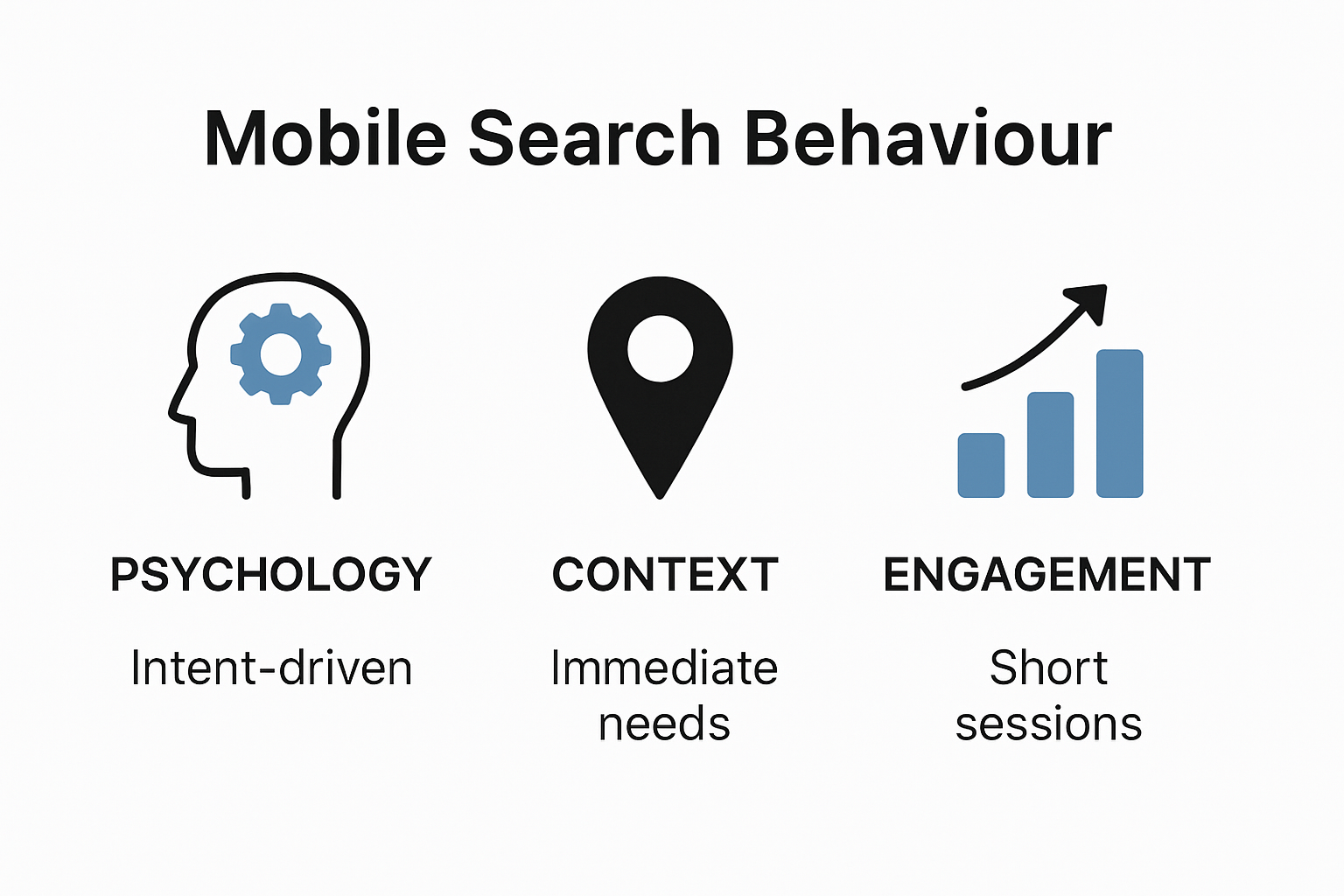Mobile SEO Strategies for 2025: Tips for Canadian Businesses

Mobile browsing already makes up over 60 percent of all searches in Canada , pushing businesses to fight harder for attention on tiny screens. That sounds like a good excuse to just copy your desktop content and hope for the best, right? Actually, treating mobile users as an afterthought is the quickest way to lose them fast and watch your rankings drop.
Table of Contents
Quick Summary
| Takeaway | Explanation |
|---|---|
| Prioritize mobile site speed | Aim for page load times under 2 seconds to reduce bounce rates and retain users. |
| Optimize for local searches | Utilize local keywords and ensure your Google Business Profile is accurate and up-to-date. |
| Enhance user experience design | Create touch-friendly navigation and readable content to engage mobile users effectively. |
| Implement advanced analytics | Utilize tools to track user behavior and refine strategies based on data insights. |
| Adapt to changing SEO trends | Regularly update SEO tactics to align with emerging technologies and user preferences. |
Understanding Mobile SEO and User Behaviour
Mobile search behaviour has transformed dramatically in recent years, compelling businesses to rethink their digital strategies. Understanding how users interact with mobile devices provides critical insights for developing effective mobile SEO strategies.
The Mobile Search Psychology
User behaviour on mobile devices differs significantly from desktop interactions. According to the Public awareness and attitudes towards search engine optimization study , only 29.2% of users understand how search ads differ from organic results. This knowledge gap highlights the complexity of mobile user interactions and the need for precise, targeted content.
Mobile users typically seek quick, contextually relevant information. Their search patterns are often driven by immediate needs - finding directions, checking product reviews, or solving urgent problems. These micro-moments demand concise, easily digestible content that loads rapidly and provides immediate value.
Context and Search Relevance
Research on Mobile Search Task Relevance reveals that mobile search behaviour is deeply influenced by user context. Location, time of day, and current activity dramatically shape search queries and expectations. For instance, a user searching for restaurants at 6 PM will have different intent compared to the same search at 11 AM.
Businesses must design mobile SEO strategies that anticipate and respond to these contextual nuances. This means creating content that not only matches keywords but understands and addresses the underlying user intent. Geolocation targeting, time-sensitive content, and mobile-friendly design become crucial elements in capturing mobile user attention.

Engagement and User Experience
Dwell time - the duration users spend on a webpage - is a critical metric in mobile SEO. Analysis of User Dwell Time research demonstrates that mobile users have distinct engagement patterns compared to desktop users. Their interactions are often shorter, more focused, and more likely to be abandoned if the content doesn’t immediately meet their expectations.
To optimize mobile SEO, businesses must prioritize:
- Fast Loading Speeds : Mobile users expect websites to load within 2-3 seconds.
- Responsive Design : Content must be readable and navigable on smaller screens.
- Simplified Navigation : Reduce complex menus and provide clear, direct pathways to information.
Understanding these behavioural nuances allows businesses to craft mobile SEO strategies that genuinely resonate with user needs, improving search rankings, user engagement, and ultimately, conversion rates.
Optimizing Website Speed and Mobile Experience
Website speed and mobile experience are fundamental pillars of successful mobile SEO strategies. In an era where users expect instantaneous digital interactions, businesses must prioritize performance and user-centric design to remain competitive.
Performance Metrics and Search Rankings
According to research on mobile SEO techniques , search algorithms increasingly weight website performance as a critical ranking factor. Mobile users are notably intolerant of slow-loading websites, with studies showing that a delay of mere seconds can dramatically increase bounce rates.
Key performance metrics businesses must monitor include:
- Page Load Time : Ideal loading times should be under 2 seconds
- Time to First Byte : Measuring server response speed
- Mobile Responsiveness : Ensuring seamless display across device sizes
Technical Optimization Strategies
Technical optimization requires a multifaceted approach. Compressing images, minimizing code complexity, and implementing efficient caching mechanisms are essential techniques. Web developers should focus on:
- Reducing image file sizes without compromising visual quality
- Eliminating render-blocking JavaScript and CSS
- Leveraging browser caching to improve subsequent page loads
Additionally, implementing Accelerated Mobile Pages (AMP) can significantly enhance mobile page performance. AMP provides a streamlined HTML framework designed specifically for rapid mobile rendering, helping websites achieve near-instantaneous load times.
User Experience and Engagement
Beyond technical performance, mobile experience encompasses intuitive navigation, readable content, and seamless interaction design. Touchscreen-friendly interfaces, legible typography, and strategically placed call-to-action buttons contribute to positive user experiences.
Businesses should conduct regular mobile usability testing, utilizing tools that simulate various device types and network conditions. This approach helps identify potential friction points in the mobile user journey and allows for continuous optimization.
By prioritizing website speed and crafting exceptional mobile experiences, businesses can not only improve search rankings but also build stronger connections with their digital audience. The key lies in understanding that mobile optimization is an ongoing process of refinement and adaptation.

Local Mobile SEO Tips for Canadian Businesses
Local mobile SEO represents a critical strategy for Canadian businesses seeking to attract nearby customers and improve digital visibility. With mobile searches increasingly dominating local search results, understanding targeted optimization techniques becomes essential for sustainable growth.
Google Business Profile Optimization
Research on local SEO strategies emphasizes the importance of maintaining a comprehensive Google Business Profile. This digital asset serves as a primary touchpoint for local mobile searches, allowing businesses to showcase critical information directly in search results.
Key optimization strategies include:
- Accurate Business Information : Ensure name, address, phone number, and operating hours are current
- High-Quality Visual Content : Upload professional photos representing your business environment
- Regular Updates : Post weekly content, respond to reviews, and maintain active engagement
Mobile-Specific Local Keyword Targeting
Digital research indicates that 46% of Google searches have a local intent. Canadian businesses must develop mobile-specific keyword strategies that capture local search nuances. This involves incorporating location-based terms, regional identifiers, and conversational language that mobile users typically employ.
Effective local keyword strategies include:
- Using city or province names in content
- Implementing neighborhood-specific terminology
- Creating content that answers location-based queries
Mobile User Experience and Local Visibility
Mobile optimization research reveals that over 60% of searches occur on mobile devices. This statistic underscores the critical need for a mobile-first approach to local SEO. Businesses must prioritize responsive design, rapid loading speeds, and intuitive navigation to capture and retain local mobile traffic.
Crucial mobile user experience elements include:
- Responsive Design : Websites that adapt seamlessly across different device sizes
- Touch-Friendly Navigation : Large, easily tappable buttons and menus
- Localized Content : Tailoring information to address regional customer needs
By implementing these targeted mobile local SEO strategies, Canadian businesses can significantly enhance their digital visibility, attract more nearby customers, and create meaningful online connections that drive real-world engagement.
Tracking Success and Updating Mobile SEO Tactics
Successful mobile SEO is not a static process but a dynamic journey of continuous measurement, analysis, and adaptation. Canadian businesses must develop robust tracking mechanisms to understand their digital performance and remain agile in an ever-evolving digital landscape.
Key Performance Metrics and Analytics
Research from the National Institute of Standards and Technology emphasizes the critical importance of comprehensive monitoring for digital strategies. For mobile SEO, this translates into tracking a comprehensive set of performance indicators that provide holistic insights into user behaviour and website effectiveness.
Essential metrics businesses should monitor include:
- Mobile Traffic Percentage : Understanding the proportion of visitors from mobile devices
- Bounce Rate : Measuring how quickly users leave the website
- Average Session Duration : Tracking user engagement levels
- Conversion Rate : Evaluating the effectiveness of mobile user interactions
Advanced Analytics and User Behaviour Insights
Modern mobile SEO requires going beyond surface-level metrics. Advanced analytics tools enable businesses to gain deeper understanding of user interactions, revealing nuanced insights about mobile user preferences and behaviour patterns.
Strategic approaches to advanced analytics include:
- Implementing heat mapping technologies
- Conducting user flow analysis
- Tracking micro-conversions and interaction points
- Segmenting data by device type, location, and user demographics
Continuous Optimization and Adaptation
The digital ecosystem evolves rapidly, demanding that businesses remain flexible and responsive. Mobile SEO strategies must be treated as living documents, continuously refined based on empirical data and emerging technological trends.
Key optimization strategies involve:
- Regular Performance Audits : Conducting comprehensive reviews every quarter
- Competitive Benchmarking : Comparing performance against industry standards
- Technology Adaptation : Staying informed about mobile search algorithm updates
- User Feedback Integration : Incorporating direct user insights into optimization efforts
By embracing a data-driven approach to mobile SEO, Canadian businesses can develop resilient digital strategies that not only respond to current trends but anticipate future shifts in mobile search behaviour. The goal is not merely to track performance but to transform insights into actionable improvements that drive meaningful digital engagement.
To help visualize the most important performance indicators for effective mobile SEO, here is a summary table outlining essential metrics to track, what they measure, and why they’re important:
| Metric | What it Measures | Why it Matters |
|---|---|---|
| Mobile Traffic Percentage | Proportion of visitors from mobile | Reveals importance of mobile audience |
| Bounce Rate | Rate at which users leave quickly | Indicates content or usability issues |
| Average Session Duration | Length of user’s visit | Reflects user engagement |
| Conversion Rate | Percentage completing a desired action | Shows effectiveness of mobile interactions |
| Time to First Byte | Server response speed | Impacts perceived and actual load time |
| Page Load Time | How long pages take to fully display | Strongly affects user retention and ranking |
Below is a checklist table summarizing technical and user experience strategies mentioned for optimizing mobile websites. Use this as a reference for essential optimization actions:
| Optimization Area | Action/Technique | Implemented (Y/N) |
|---|---|---|
| Image Optimization | Compress image file sizes | |
| Code Optimization | Eliminate render-blocking JS & CSS | |
| Caching | Leverage browser caching | |
| AMP | Implement Accelerated Mobile Pages (AMP) | |
| Mobile Design | Ensure responsive and touch-friendly UI | |
| Usability Testing | Test across devices and network speeds | |
| Local Content | Add city/region-based keywords |
Frequently Asked Questions
What are the key mobile SEO strategies for Canadian businesses in 2025?
Key strategies include optimizing website speed, enhancing user experience with responsive design, implementing local keyword targeting, and maintaining an updated Google Business Profile.
How can Canadian businesses improve mobile website speed?
To improve mobile website speed, businesses should compress images, minimize code, leverage browser caching, and consider implementing Accelerated Mobile Pages (AMP).
Why is local mobile SEO important for businesses in Canada?
Local mobile SEO is crucial because it helps businesses attract nearby customers by improving visibility in local search results, especially as a significant portion of mobile searches have local intent.
What metrics should I track to evaluate my mobile SEO performance?
Key metrics include mobile traffic percentage, bounce rate, average session duration, conversion rate, page load time, and time to first byte. These metrics help understand user engagement and website effectiveness.
Ready to Make Your Mobile SEO Work for Canadian Customers?
You just read why mobile speed, local search, and user experience are critical for competing in 2025. Still struggling with slow load times or being invisible on Google Maps? If your local business is not showing up where your customers search, you risk losing them to faster competitors. When every second and search matters, your business cannot afford to get left behind. The right partner can help you build a mobile-friendly site, fine-tune your Google Business Profile Management (Local Map) , and implement techniques that truly boost your ranking.

Take action right now before your competitors take your spot. Visit Freedom SEO for a free consultation and see how our proven methods can get you into Google’s top 3—fast. Want results that drive real calls and customers? Reach out today and let’s make your business easy to find for every mobile searcher in Canada.
Recommended
















